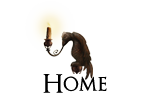The Blue Men are particular favourites of mine, having written about them in my own mythical journey round the tales of Britain, Coll the Storyteller's Tales of Enchantment. This is how I described them:
"There were Great Ones of pure light who danced in the lands above the sky. Time did not pass for them, for there was no time. Distance did not matter to them, for there was no distance...but one day Others appeared in their lands and began to dance too. Instead of pure light, they were made of something different, and as their dancing grew stronger, their whirling forms began to cover the pure white skirts of the Great Ones with patterns of colour. And the colour was blue..."I'm always fascinated to see how other authors see the mythic beings I love, and Gillian's beautifully informative piece taught me a thing or two I didn't know. So without further ado, I shall hand you over to her.
B for Blue Men of the Minch
The Nimble Dancers of the Waves
GP: Water monsters are my absolute favourites, from kelpies to selkies (and I know selkies aren’t traditionally ‘monsters’, but mine are), so when Lucy asked me to write about the Blue Men of the Minch, who had been a little under my sonar till now, I rushed to my copy of John Gregorson Campbell’s The Gaelic Otherworld to investigate.
They’re very particular to a location, the Blue Men - na Fir Ghorma - living only in a strait between the island of Lewis and the Shiants, Sruth nam Fear Gorma - the stream of the Blue Men, aka the Current of Destruction. It’s here they lurk in the waters, looking to capsize boats for no other reason than mischief and pride (at least, unlike the more famous kelpies or water horses, they don’t have any plans to eat you). According to one tale, the only way to outwit them is to be better at rhyming couplets, as proved by a certain captain of a ship with snow-white sails, pursued by na Fear Ghorma:
Man of the black cap, what do you sayAs your proud ship cleaves the brine?’‘My speedy ship takes the shortest wayAnd I’ll follow you line by line.’‘My men are eager, my men are readyTo drag you beneath the waves.’‘My ship is speedy, my ship is steady,If it sank it would wreck your caves.’
 |
| The Blue Men of the Minch, iPad illustration copyright (c) Lucy Coats |
On hearing this, says the tale, the Blue chieftain gave up in disgust, realising he could never defeat a man with such aptitude for off-the-cuff doggerel.
It’s easy to see why the legend of the Blue Men arose. There are many treacherous waters in the Minch, but the channel where the Blue Men are said to lurk can be wild and vicious even when the rest of the sea is calm. They take the appearance of blue figures with streaming white hair who rise from the water, clutching at boats and dragging them down.
I took the title for my Rebel Angels series from an old Highland myth. The fallen angels, driven out of Paradise, scattered in three directions: some fell on the land and became the faeries, some fell into the sea to become selkies, and the rest were caught in the sky and remain there as the Northern Lights. But the myth has many variations, and of course in the north Hebrides the sea-bound angels became the Blue Men. Fair play to the north Hebrides.
Now, even a scheming fallen angel has to take a break sometimes, and there’s a popular story about one who was caught basking on the waves on an unusually calm day in the Minch. A boat passing by took the chance to capture one of the feared Blue Men; pulling him aboard, still asleep, they bound him tightly from head to foot. Two of his comrades, however, raced to save him. One called out, ‘Duncan will be one man’, and the other replied ‘Farquhar will be two.’ Their voices woke the captive, who shouted ‘Iain Mhor has no need of help!’ Leaping to his feet, he broke his bonds like a spider web and dived back into the water, leaving the fishermen with nothing but broken rope and the knowledge that Blue Men have perfectly ordinary names.
It’s easy to see why the legend of the Blue Men arose. There are many treacherous waters in the Minch, but the channel where the Blue Men are said to lurk can be wild and vicious even when the rest of the sea is calm. They take the appearance of blue figures with streaming white hair who rise from the water, clutching at boats and dragging them down.
I took the title for my Rebel Angels series from an old Highland myth. The fallen angels, driven out of Paradise, scattered in three directions: some fell on the land and became the faeries, some fell into the sea to become selkies, and the rest were caught in the sky and remain there as the Northern Lights. But the myth has many variations, and of course in the north Hebrides the sea-bound angels became the Blue Men. Fair play to the north Hebrides.
Now, even a scheming fallen angel has to take a break sometimes, and there’s a popular story about one who was caught basking on the waves on an unusually calm day in the Minch. A boat passing by took the chance to capture one of the feared Blue Men; pulling him aboard, still asleep, they bound him tightly from head to foot. Two of his comrades, however, raced to save him. One called out, ‘Duncan will be one man’, and the other replied ‘Farquhar will be two.’ Their voices woke the captive, who shouted ‘Iain Mhor has no need of help!’ Leaping to his feet, he broke his bonds like a spider web and dived back into the water, leaving the fishermen with nothing but broken rope and the knowledge that Blue Men have perfectly ordinary names.
Unlike the Blue Men, I’m captivated. They will without doubt be making an appearance in a future book - thank you, Lucy - because I’m sure they’re well known both to my kelpies and to my Selkyr. And I can’t imagine my Sithe - Seth and Conal and the rest - would pass up a chance for a lively confrontation.
Not if I have anything to do with it...
There’s a poem about na Fear Ghorma that sums up their moods. Anyone who’s seen the Hebrides will recognise that the seas around them share their temper. It’s by Donald A. Mackenzie and I can’t resist reproducing it here:
When the tide is turning and the wind is fast asleep,
And not a wave is curling on the wide, blue deep,
Oh, the waters will be churning in the stream that never smiles,
Where the Blue Men are splashing round the Shiant Isles!As the summer wind goes droning o’er the sun-bright seas,
And the Minch is all a-dazzle to the Hebrides,
They will skim along like salmon - you can see their shoulders gleam,
And the flashing of their fingers in the Blue Men’s stream.
But when the blast is raving and the wild tide races,
The Blue Men are breast-high with foam-grey faces;
They’ll plunge along with fury while they sweep the sea behind;
Oh, they’ll bellow o’er the billows and wail upon the wind.And if my boat be storm-tossed and beating for the bay,
They’ll be howling and be growling as they drench it with their spray; -
For they’d like to heel it over to their laughter when it lists,
Or crack the keel behind them, or stave it with their fists.
Oh, weary on the Blue Men, their anger and their wiles!
The whole day long, the whole night long, they’re splashing round the isles;
They’ll follow every fisher - ah! They’ll haunt the fisher’s dream -
When billows toss, oh! Who would cross the Blue Men’s stream?
SCC: Who indeed? Thank you so much, Gillian - that was a poem I didn't know, and I'm so glad to be introduced to it, as it sums up the Blue Men and their wild, storm-tossed natures exactly.
Next week: Madeline Miller, author of The Song of Achilles (SCC's Book of the Year for 2011) talks about C for Centaurs










































